Order Lepidoptera
The butterfly is a fascinating, beneficial insect that plays essential roles in the environment and is appreciated for its beauty and diversity by people all over the world.
Butterflies belong to the order Lepidoptera, which also includes moths. There are over 18,000 known species of butterflies worldwide, classified into various families and genera based on their characteristics.
The diversity of butterfly species varies significantly across different continents and countries:
It’s important to note that these numbers are approximations and may vary depending on the sources and the criteria used for counting species (resident vs. migrant, endemic vs. introduced, etc.). Additionally, ongoing research and exploration continue to document new species and revise existing classifications, which can also affect species counts.
Butterflies are incredibly diverse and generally categorized based on their families, of which there are six major ones:
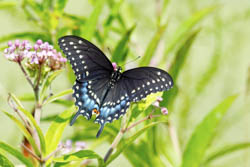 Black Swallowtail Butterfly Black Swallowtail Butterfly |
Papilionidae (Swallowtails and Parnassians) The Papilionidae family includes over 550 species featuring large, colorful butterflies. They are easily identifiable by their distinctive tails resembling swallow birds. Their caterpillars are often equally colorful with unique, defensive osmeteria. These butterflies play crucial roles in pollination and are popular among collectors. |
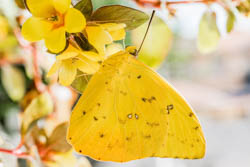 Butterfly Cloudless Sulphur Butterfly Cloudless Sulphur |
Pieridae (Whites and Sulphurs) The Pieridae family consists of about 1,100 species, predominantly characterized by white or yellow wings, although some species display orange-tipped wings or greenish marbling on the wings. They are small to medium in size and prefer open areas like fields and meadows. The caterpillars of certain butterfly species, such as Pieris brassicae and Pieris rapae, have a particular appetite for brassicas and have gained notoriety as significant pests in the agricultural sector. |
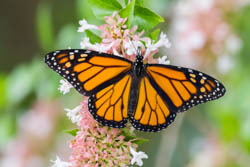 Monarch Butterfly Monarch Butterfly |
Nymphalidae (Brush-Footed Butterflies) Nymphalidae is the largest butterfly family, housing over 6,000 species. Their front legs are reduced in size, giving them a characteristic “brush-footed” appearance. This diverse group includes popular species such as the emperors, monarch butterfly, admirals, tortoiseshells, and fritillaries. They inhabit a variety of ecosystems, contributing significantly to pollination. |
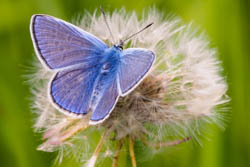 Common Blue Butterfly Common Blue Butterfly |
Lycaenidae (Blues, Coppers, and Hairstreaks) The Lycaenidae family encompasses around 5,000 species of small butterflies. They showcase vibrant colors and intricate patterns. Many species engage in mutualistic relationships with ants. They frequent diverse habitats, from forests to grasslands, playing a role in maintaining ecological balance through pollination. |
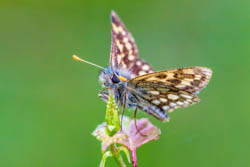 Chequered Skipper Chequered Skipper |
Hesperiidae (Skippers)
Hesperiidae, commonly known as Skippers, are a large butterfly family distinguished by their rapid, erratic flight patterns. They possess stout bodies, large heads, and hooked antennae. With over 3,500 species worldwide, they inhabit diverse environments, including meadows and woodlands. Skippers are vital in pollination, particularly for certain types of flowers. |
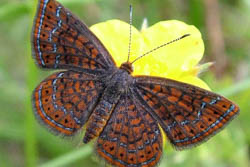 Swamp Metalmark Swamp Metalmark |
Riodinidae (Metalmarks)
Riodinidae, or Metalmarks, are a smaller butterfly family with about 1,500 species. They are known for their metallic markings and intricate wing patterns. These butterflies are typically small and inhabit tropical regions, contributing to the rich biodiversity of these ecosystems through their roles in pollination. |
Within these families, there are numerous genera and species, each with their unique characteristics and adaptations. The types of butterflies in a specific region depend on the climate, vegetation, and available habitats.
Butterflies are known for their colorful wings, which are covered in tiny scales. The wingspan of a butterfly can range from less than an inch to over a foot (2-30 cm), depending on the species.
Butterflies use their wings not only for flight but also to regulate their body temperature. When they are warm, they open their wings to release heat, and when they are cold, they close their wings to conserve heat. Some species of butterflies are also capable of flying great distances, including migrations of hundreds or even thousands of miles.
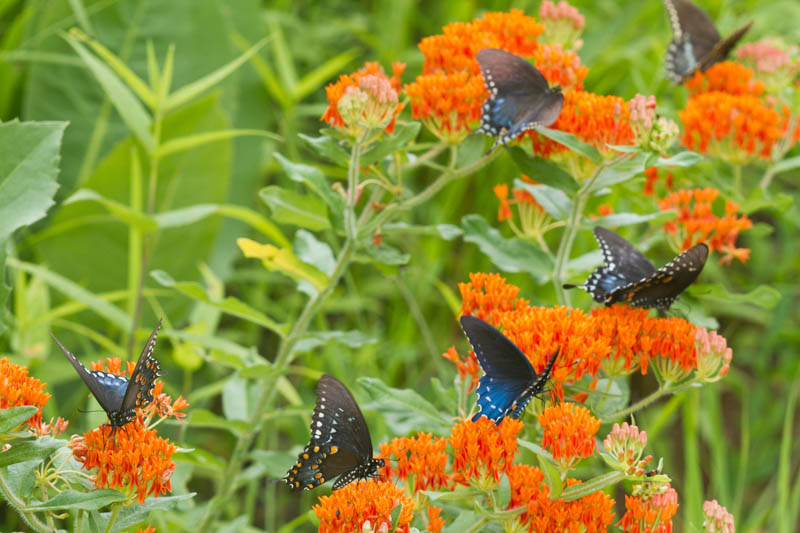 Pipevine Swallowtails (Battus philenor) on Butterfly Milkweed (Asclepias tuberosa)
Pipevine Swallowtails (Battus philenor) on Butterfly Milkweed (Asclepias tuberosa)
The life cycle of a butterfly consists of four stages: egg, larva (caterpillar), pupa (chrysalis), and adult. Here’s a brief overview of each stage:
The entire life cycle of a butterfly can range from a few weeks to several months, depending on the species and environmental conditions. But despite the differences between species, the life cycle of a butterfly is a remarkable example of metamorphosis and the beauty and diversity of life on Earth.
Butterflies primarily feed on nectar from flowers, using their long, coiled proboscis to sip the liquid. Their diet helps to pollinate plants, playing a crucial role in ecosystems. However, their feeding preferences can vary based on species, and some butterflies may also feed on:
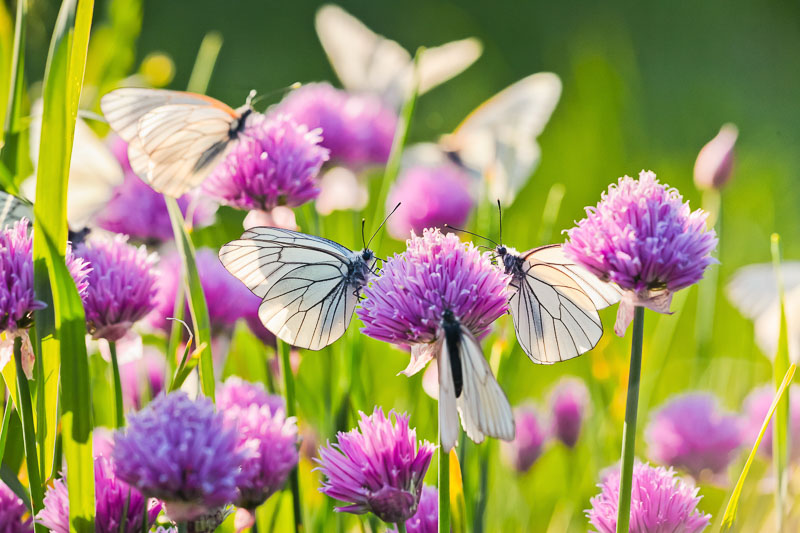 Cabbage butterflies (Pieris brassicae) pollinate the flower of chives
Cabbage butterflies (Pieris brassicae) pollinate the flower of chives
Butterflies have a keen sense of smell and vision, which help them locate their preferred food sources. Additionally, their diet can influence their mating success, as males that consume specific nutrients can produce more attractive pheromones.
While adult butterflies primarily consume liquid diets, their larvae, or caterpillars, feed on solid food. Caterpillars typically eat leaves, but some species may feed on seeds, flowers, or other parts of plants. The specific diet of a caterpillar depends on its species and the types of plants available in its habitat.
Butterflies are known for their impressive migratory capabilities, and the distance they can fly largely depends on the species. Here are some notable examples and general information:
Butterflies’ ability to travel long distances is crucial for their survival, as it allows them to escape unfavorable conditions, find mates, and reach breeding and feeding grounds. Despite their delicate appearance, butterflies are resilient and capable of remarkable feats of navigation and endurance.
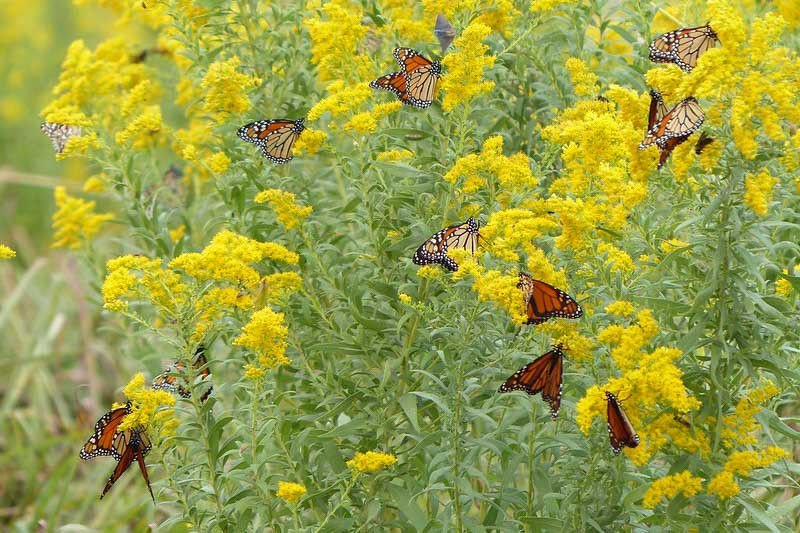 Monarch Butterflies on Goldenrod Flowers (Solidago)
Monarch Butterflies on Goldenrod Flowers (Solidago)
Butterflies play vital roles in ecosystems around the world, contributing to biodiversity and performing essential ecological functions. Here’s why they are important:
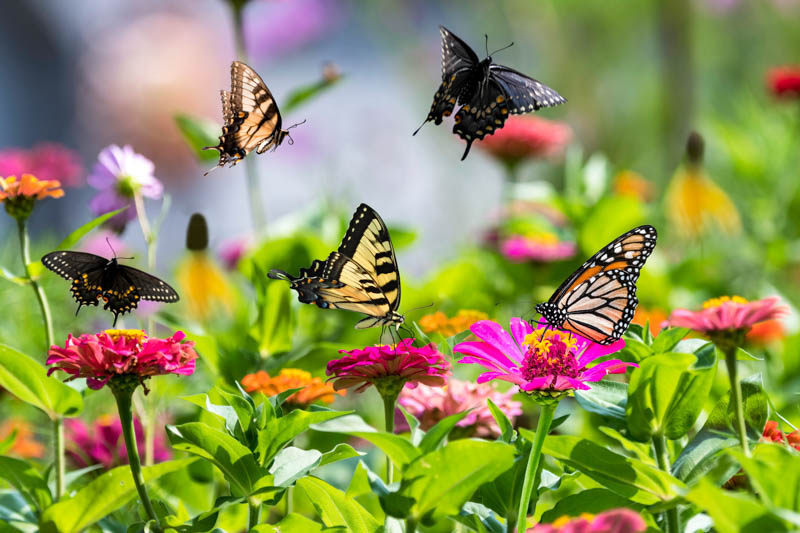
Creating a beautiful butterfly garden involves careful planning and selection of plants to attract these colorful insects. Here’s a step-by-step guide to help you establish a haven for butterflies:
Caterpillar host plants are specific plants that caterpillars of particular butterfly or moth species feed on. The relationship between caterpillars and their host plants is crucial for their survival.
Accept Some Damage: Be prepared for caterpillars to eat the leaves of these plants, as this is a crucial part of their life cycle.
By following these steps, you can create a stunning and functional butterfly garden that supports local wildlife and provides enjoyment for years to come.
Darkdiamond67, Danita Delimont, Julia Shepeleva, Shutterstock, USFWS Mountain Prairie, Flickr
Create a membership account to save your garden designs and to view them on any device.
Becoming a contributing member of Gardenia is easy and can be done in just a few minutes. If you provide us with your name, email address and the payment of a modest $25 annual membership fee, you will become a full member, enabling you to design and save up to 25 of your garden design ideas.
Join now and start creating your dream garden!
Create a membership account to save your garden designs and to view them on any device.
Becoming a contributing member of Gardenia is easy and can be done in just a few minutes. If you provide us with your name, email address and the payment of a modest $25 annual membership fee, you will become a full member, enabling you to design and save up to 25 of your garden design ideas.
Join now and start creating your dream garden!